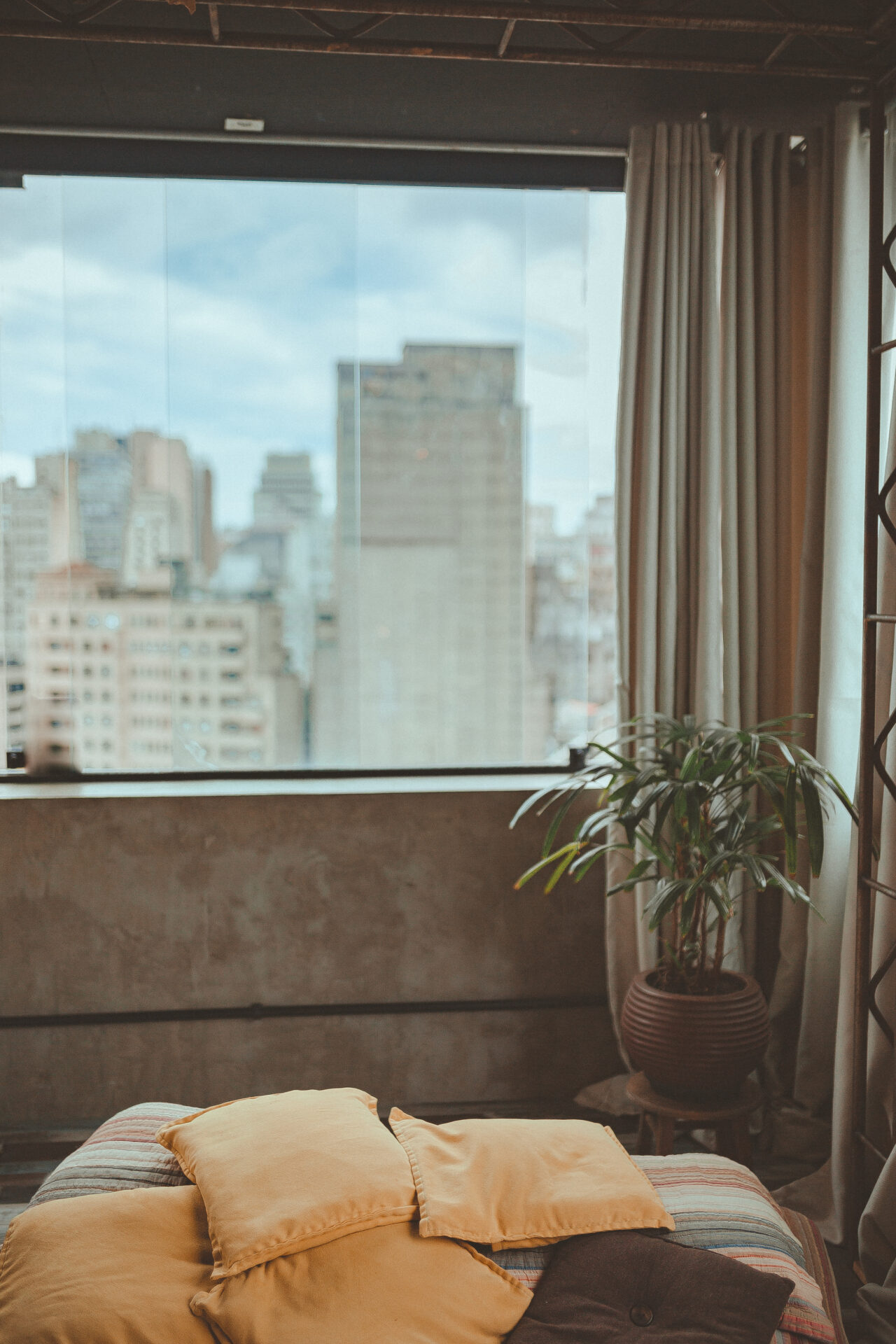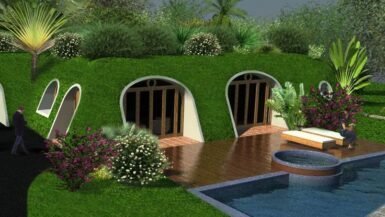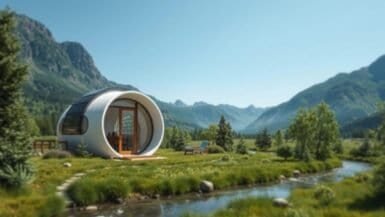As the tiny home movement continues to gain momentum, enthusiasts are constantly seeking innovative ways to maximize space while reducing their environmental footprint. One such method is the incorporation of living walls into their home design. In this article, we will delve into the concept of living walls, exploring their numerous benefits and practical applications in the context of tiny homes. From alleviating indoor air pollution to enhancing aesthetics, we will provide you with valuable insights and guidance on how to seamlessly integrate living walls into your tiny home’s architecture, ensuring a sustainable and harmonious living space.
Benefits of Living Walls in Sustainable Tiny Homes
Living walls are an innovative and eco-friendly addition to tiny homes that can greatly enhance their inhabitants’ quality of life. These vertical gardens not only add an aesthetic appeal to your home, but also provide a variety of practical benefits. In this section, we will explore the advantages of incorporating living walls into your tiny home design, ranging from improved air quality to noise reduction.
Enhancing Indoor Air Quality
One of the primary benefits of living walls is their ability to purify the air within your home. Plants naturally filter out pollutants and toxins, such as volatile organic compounds (VOCs), which are commonly found in building materials and household products. By incorporating living walls into your tiny home, you can significantly improve your indoor air quality, thereby promoting a healthier living environment.
Optimizing Space Utilization
In a tiny home, every square foot counts. Living walls allow you to make the most of your limited space by providing a vertical gardening solution. This not only adds greenery to your home without compromising floor space but can also be used to grow herbs and vegetables, incorporating a sustainable food source into your living space.
Boosting Energy Efficiency
Living walls act as natural insulators, helping to regulate your home’s temperature while reducing energy consumption. In the warmer months, the plants absorb sunlight and provide shade, keeping your home cooler. Conversely, during colder seasons, living walls help to insulate your home, retaining heat and reducing the need for additional heating.
Reducing Noise Pollution
Plants are natural sound absorbers, and living walls can significantly dampen noise pollution within your home. This is particularly beneficial for tiny homes situated in urban areas, where external noise can be a significant concern. By incorporating a living wall into your design, you can create a more serene and peaceful atmosphere.
Enhancing Aesthetics and Well-being
Finally, living walls bring a touch of nature into your home, creating an aesthetically pleasing and calming environment. Research has shown that exposure to nature can improve mental well-being, reduce stress, and increase productivity. By integrating a living wall into your tiny home design, you can create a sanctuary that promotes relaxation and rejuvenation.
Incorporating living walls into your tiny home design not only enhances the aesthetics of your space but also provides numerous practical benefits. From improving air quality to optimizing space utilization, living walls are a smart and sustainable solution for those seeking to create a harmonious and eco-friendly living environment.
Choosing the Right Plants for Your Tiny Home Living Wall
When incorporating a living wall into your tiny home design, selecting the appropriate plants is crucial to ensure the success and longevity of your vertical garden. The right plants will not only thrive in your space but also contribute to the overall function and aesthetics of your living wall. In this section, we will discuss key factors to consider when choosing plants for your living wall, as well as some popular plant options that are well-suited to tiny home environments.
Light and Temperature Requirements
Before selecting plants for your living wall, assess the light and temperature conditions in your tiny home. Consider the amount of natural light your space receives, as well as any fluctuations in temperature throughout the day. This information will help you choose plants that are compatible with your specific environment. For example, if your tiny home receives abundant sunlight, opt for sun-loving plants such as succulents or herbs. Conversely, if your space has limited light, select shade-tolerant species like ferns or pothos.
Size and Growth Habits
When choosing plants for your living wall, it’s essential to consider their mature size and growth habits. Opt for plants with a compact growth habit and manageable size to ensure they don’t outgrow your living wall or require excessive maintenance. Some suitable options include small ferns, ivy, and bromeliads, which can easily adapt to the confined space of a tiny home living wall.
Maintenance and Care
Given the limited space and resources in a tiny home, it’s important to select plants that are low-maintenance and easy to care for. Drought-tolerant plants, such as succulents, are an excellent choice for busy homeowners, as they require minimal watering and upkeep. Additionally, consider selecting plants that are resistant to pests and diseases to minimize the need for intervention and ensure the longevity of your living wall.
Functionality and Aesthetics
Finally, when selecting plants for your living wall, consider the functional benefits and visual appeal they will bring to your tiny home. For instance, you may choose plants with air-purifying properties, such as spider plants or snake plants, to improve your indoor air quality. Alternatively, you can opt for plants with vibrant foliage or interesting textures, such as calatheas or mosses, to create a visually striking feature that complements your interior design.
By carefully considering factors such as light and temperature requirements, size and growth habits, maintenance, and functionality, you can select the perfect plants for your tiny home living wall. By doing so, you will ensure a thriving, sustainable, and visually appealing addition to your living space that enhances both the form and function of your tiny home.
Vertical Garden Solutions for Small Spaces
Incorporating living walls into tiny home design can be a challenging task due to the limited space available. However, with the right approach and creative solutions, it is possible to create a thriving vertical garden that seamlessly integrates with your home’s design and layout. In this section, we will explore various vertical garden solutions specifically tailored for small spaces, ensuring that your living wall not only fits within your tiny home but also enhances its overall functionality and aesthetics.
Modular Living Wall Systems
One of the most versatile solutions for small spaces is the use of modular living wall systems. These systems typically consist of individual planters that can be easily attached to a wall or frame, allowing you to customize your living wall based on your available space and design preferences. This flexibility is particularly beneficial for tiny homes, as it enables you to create a living wall that fits your specific needs and constraints. Some popular modular living wall systems include pocket planters, vertical planter boxes, and wall-mounted planter panels.
Freestanding Vertical Gardens
If wall space is limited in your tiny home, consider utilizing a freestanding vertical garden to incorporate a living wall into your design. These self-contained units typically include a frame or structure that supports the plants, as well as a built-in irrigation system. Freestanding vertical gardens can be easily moved or repositioned as needed, providing flexibility in your tiny home layout. Examples of freestanding vertical gardens include plant ladder shelves, vertical plant stands, and mobile plant walls.
Hanging Gardens and Wall Trellises
Another space-saving solution for tiny homes is the use of hanging gardens or wall trellises. These systems involve suspending plants from your ceiling or attaching them to a trellis, allowing you to take advantage of vertical space without occupying valuable wall or floor real estate. Hanging gardens and wall trellises can be particularly effective in areas with high ceilings or in front of windows, where they can benefit from natural light. Some examples of hanging garden systems include macramé plant hangers, hanging baskets, and wall-mounted trellises with climbing plants.
Maximizing Space with Multi-Functional Features
In a tiny home, it’s essential to make the most of every square inch of space. One way to do this is by incorporating multi-functional features into your living wall design. For example, you can combine your living wall with storage solutions such as shelving or wall-mounted cabinets, allowing you to maximize space utilization while still enjoying the benefits of a vertical garden. Additionally, you can integrate your living wall with other functional elements, such as room dividers or privacy screens, to further enhance the versatility and utility of your space.
By exploring various vertical garden solutions tailored for small spaces, you can successfully incorporate a living wall into your tiny home design. From modular living wall systems to multi-functional features, these creative solutions enable you to create a thriving, sustainable, and visually appealing living wall that enhances the overall functionality and aesthetics of your tiny home.
DIY Living Wall Installation and Maintenance Tips
Creating a living wall in your tiny home can be a rewarding and fulfilling project. With a little creativity, planning, and maintenance, you can have a thriving vertical garden that enhances your living space and promotes sustainability. In this section, we will provide you with practical tips and guidance on how to install and maintain a DIY living wall, ensuring its long-term success and vitality.
Selecting the Right Location
The first step in installing a living wall is selecting the ideal location within your tiny home. Consider factors such as light exposure, temperature, and humidity, as these will greatly impact the health of your plants. Additionally, take into account the weight and structural support needed for your living wall, ensuring that your chosen location can accommodate these requirements.
Choosing an Appropriate Framework
Once you have identified the perfect location for your living wall, it’s essential to select an appropriate framework. This will depend on factors such as the size and type of plants you plan to use, your available space, and your overall design aesthetic. Some popular DIY living wall frameworks include wooden pallets, plastic trays with pockets, and wire mesh with pockets or containers. Whichever framework you choose, ensure it provides adequate support and drainage for your plants.
Preparing and Planting Your Vertical Garden
With your location and framework in place, it’s time to prepare and plant your living wall. Begin by selecting a high-quality potting mix that provides the necessary nutrients and drainage for your plants. Fill your chosen containers or pockets with the potting mix, and carefully plant your chosen vegetation. Be sure to arrange your plants in a visually appealing manner, taking into account their growth habits and mature size.
Installing an Efficient Irrigation System
A key factor in maintaining a healthy living wall is ensuring proper irrigation. Consider installing a drip irrigation system, which delivers water directly to the roots of your plants, minimizing water waste and promoting efficient plant growth. Alternatively, you can opt for a manual watering method, such as using a spray bottle or watering can, but be prepared to dedicate more time and effort to ensure consistent moisture levels.
Regular Maintenance and Care
To ensure the long-term success of your living wall, it’s crucial to perform regular maintenance and care. This includes monitoring the health of your plants, pruning and trimming as necessary, and checking for signs of pests or diseases. Additionally, be sure to regularly assess the integrity of your living wall’s framework and irrigation system, making any necessary repairs or adjustments to maintain its functionality and appearance.
By following these DIY living wall installation and maintenance tips, you can create a thriving vertical garden that enhances your tiny home’s aesthetics and promotes a sustainable lifestyle. With careful planning, proper irrigation, and regular maintenance, your living wall will be a beautiful and functional addition to your living space.
Maximizing Space and Functionality with Living Wall Design
Incorporating a living wall into your tiny home design can serve multiple purposes, from enhancing aesthetics to optimizing space utilization. In this subsection, we will explore various strategies and design ideas to maximize both space and functionality when integrating a living wall into your tiny home. By considering factors such as plant selection, layout, and multi-functional features, you can create a vertical garden that not only elevates your interior design but also contributes to a more efficient and sustainable living environment.
Strategic Plant Selection and Arrangement
When designing a living wall for your tiny home, carefully consider the types of plants you choose and how they are arranged. Opt for plants with a compact growth habit to ensure they don’t take up too much space or require excessive maintenance. Additionally, consider arranging your plants in a way that maximizes visual interest while minimizing the overall footprint of your living wall. For example, you can create a cascading effect with trailing plants or use different leaf textures and colors to create depth and visual appeal.
Flexible and Modular Living Wall Systems
Selecting a flexible and modular living wall system can greatly enhance space efficiency in your tiny home. Modular systems, such as pocket planters or vertical planter boxes, allow you to customize your living wall based on your available space and design preferences. This adaptability is particularly beneficial in tiny homes, where every square inch counts. By carefully selecting a living wall system that can be easily adjusted or reconfigured, you can ensure that your vertical garden remains functional and space-efficient as your needs change over time.
Combining Storage and Greenery
One way to maximize space and functionality in your tiny home is by combining living wall elements with storage solutions. For example, you can incorporate built-in shelving or wall-mounted cabinets into your living wall design, allowing you to store items while also showcasing your plants. This multi-functional approach not only enhances the practicality of your living wall but also contributes to a more organized and efficient living space.
Integrating Living Walls with Functional Spaces
Another strategy to maximize space and functionality is to integrate your living wall with other functional areas of your tiny home. For instance, you can create a living wall in your kitchen area that doubles as a vertical herb garden, providing easy access to fresh ingredients while cooking. Similarly, you can incorporate a living wall into your home office space, creating a calming atmosphere that promotes focus and productivity.
Expanding Living Spaces with Outdoor Living Walls
If indoor space is limited, consider extending your living wall to the exterior of your tiny home. Outdoor living walls can create an additional living space, such as a patio or balcony, that is both visually appealing and functional. By incorporating greenery into your outdoor spaces, you can create a seamless connection between your indoor and outdoor environments, effectively expanding your living area and enhancing the overall aesthetics of your tiny home.
By thoughtfully designing your living wall to maximize space and functionality, you can create a vertical garden that truly complements your tiny home’s design and layout. Whether you opt for a modular living wall system, integrate storage solutions, or extend your living wall outdoors, these strategies will ensure that your living wall not only adds beauty to your space but also contributes to a more efficient and sustainable living environment.





Leave a reply